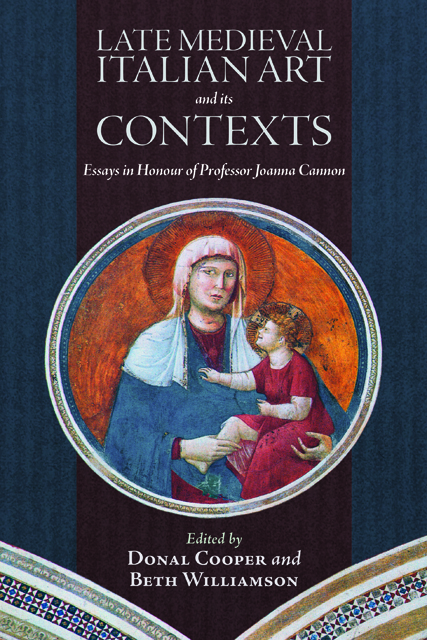Book contents
- Frontmatter
- Contents
- List of Illustrations
- List of Contributors
- Acknowledgements
- List of Abbreviations
- 1 Introduction: Circling Giotto
- 2 Holy Wood / ‘sacra tavola’: Saint Dominic and the Memory of Miracles in Bologna
- 3 The Sculpted Saint: A Statue of Saint Francis in Siena
- 4 Guccio di Mannaia and the Concept of a ‘Franciscan’ Chalice
- 5 ‘Speculum sine macula’: The Trittico di Santa Chiara in Trieste as an Object of Clarissan Devotion
- 6 The Siena Connection: A Franciscan Provincial Minister between Tuscany and Assisi at the Dawn of the Trecento
- 7 Simone Martini’s ‘Treaty with the House of Santa Fiora’ in Siena’s Palazzo Pubblico: Its Date and Significance
- 8 Crisis and Charity in Fourteenth-Century Florence: Ambrogio Lorenzetti’s Saint Nicholas Panels for San Procolo
- 9 Father of Light: Giotto and the Beatific Vision in the Baroncelli Chapel
- 10 Painter-Illuminator Workshops and the Church of San Giorgio a Ruballa: The Case of Bernardo Daddi and Pacino di Bonaguida
- 11 Patterns of Holiness: A Virgin Lactans in a Franciscan Context
- 12 A New Angle on Simone Martini’s Holy Family
- 13 Artistic Appropriation, Institutional Identity, and Civic Religion in Fourteenth-Century Siena: The Byzantine Treasury of the Hospital of Santa Maria della Scala
- 14 Visual Religious Education in Late Medieval Florence: Zanobi Perini, The Leggenda di Santo Tobia, and The Misericordia
- 15 Saints and Status in Late Medieval and Early Renaissance Florence
- Select Bibliography
- Publications by Joanna Cannon
- Index
- Tabula Gratulatoria
- Backmatter
2 - Holy Wood / ‘sacra tavola’: Saint Dominic and the Memory of Miracles in Bologna
Published online by Cambridge University Press: 20 December 2022
- Frontmatter
- Contents
- List of Illustrations
- List of Contributors
- Acknowledgements
- List of Abbreviations
- 1 Introduction: Circling Giotto
- 2 Holy Wood / ‘sacra tavola’: Saint Dominic and the Memory of Miracles in Bologna
- 3 The Sculpted Saint: A Statue of Saint Francis in Siena
- 4 Guccio di Mannaia and the Concept of a ‘Franciscan’ Chalice
- 5 ‘Speculum sine macula’: The Trittico di Santa Chiara in Trieste as an Object of Clarissan Devotion
- 6 The Siena Connection: A Franciscan Provincial Minister between Tuscany and Assisi at the Dawn of the Trecento
- 7 Simone Martini’s ‘Treaty with the House of Santa Fiora’ in Siena’s Palazzo Pubblico: Its Date and Significance
- 8 Crisis and Charity in Fourteenth-Century Florence: Ambrogio Lorenzetti’s Saint Nicholas Panels for San Procolo
- 9 Father of Light: Giotto and the Beatific Vision in the Baroncelli Chapel
- 10 Painter-Illuminator Workshops and the Church of San Giorgio a Ruballa: The Case of Bernardo Daddi and Pacino di Bonaguida
- 11 Patterns of Holiness: A Virgin Lactans in a Franciscan Context
- 12 A New Angle on Simone Martini’s Holy Family
- 13 Artistic Appropriation, Institutional Identity, and Civic Religion in Fourteenth-Century Siena: The Byzantine Treasury of the Hospital of Santa Maria della Scala
- 14 Visual Religious Education in Late Medieval Florence: Zanobi Perini, The Leggenda di Santo Tobia, and The Misericordia
- 15 Saints and Status in Late Medieval and Early Renaissance Florence
- Select Bibliography
- Publications by Joanna Cannon
- Index
- Tabula Gratulatoria
- Backmatter
Summary
A pervasive theme in Joanna Cannon’s many contributions to the study of medieval art is the relationship between form and function, set against both the wider spiritual concerns of the period and networks of patrons at specific sites and over large geographic areas. This focus led her to question deep-rooted assumptions about early Italian art and has transformed our understanding of what images might signify to multiple audiences over time. Inspired by her scholarship, I approach a category of medieval images that has been relatively little studied: painted panels that also claim to be relics or reliquie dipinte. Such a classification relates to a panel’s association with a holy individual or a miraculous event, or even the belief that it was fashioned from a sacred tree. For example, two thirteenth-century images of Saint Francis attributed to the Maestro di San Francesco (c. 1260) and to Cimabue (c. 1280), both today in the Museo della Porziuncola, Assisi, have been linked through their respective inscriptions to the wooden bier upon which the saint’s dead body rested and to the wood-lid of his first tomb. The panels are thus ‘contact’ relics – the boards believed to have once supported and covered Saint Francis’s corpse. Equally important, their sacral value stems also from the images of Saint Francis painted on the ‘holy’ surfaces and, in the case of the former, a lengthy text that has been attributed to the saint himself. Created in the early history of the Franciscan Order, the two panels provide important evidence for the representational strategies used in the promotion of ‘new’ saints (that is, images created within living memory of the holy person depicted), such as Francis – who died in 1226 and was canonized just two years later, in 1228 – as has been discussed by Joanna Cannon, amongst others. Yet in these instances, the depiction of Saint Francis together with the inscription point to the sacral value of the support, which is offered not only as a relic of the saint, but serves to validate his very image. The calibrated interplay between painted surface and material creates a series of mutually reinforcing associations brought about through representation and substantiated by its very matter, wood.
- Type
- Chapter
- Information
- Late Medieval Italian Art and its ContextsEssays in Honour of Professor Joanna Cannon, pp. 11 - 32Publisher: Boydell & BrewerPrint publication year: 2022



